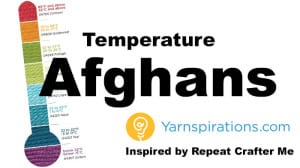
Temperature Afghan
Years ago, Bernat Yarns prior to rebranding themselves as Yarnspirations had a blog where they used a Yarn Temperature Gauge for making unique afghans, generally referred to as a Temperature Afghan.
I was reminded of this when Sarah, founder of Repeat Crafter Me, posted this as an idea for crocheters. I've been looking for this gauge and was unable to find it. Thanks, Sarah for the reminder!
Getting Data from the Past
If you don't know the temperatures of the past, you can find them pretty easily. I have written a blog on where to get the information plus there are 4 examples from Crochet Crowd Community Members to gawk at too! Where to Find Temperature Information.
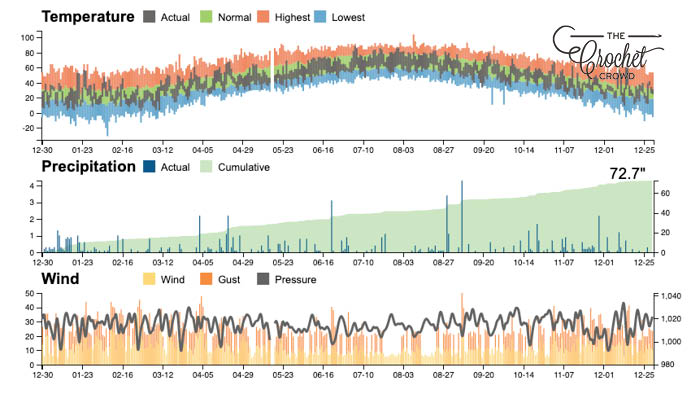
How A Temperature Afghan Works
If you have never heard of a Temperature Afghan, it's pretty straight forward. You commit to crocheting 1 - 3 rows/rounds of your work using the temperature gauge as your colour choice each day. So you can either check your temperature outside of your home or refer to the weather network each day and crochet accordingly. If you think you are not going to crochet for a day, just take the temperature and write it down so when you pick up your project, you have that information handy.
The temperature gauge is showing 6 colours of Caron One Pound yarn.
Once you know the temperature, look at your gauge and crochet the colour that falls within the temperature readings.
The trick is not to cheat the system by falsifying a temperature because you think the colour shouldn't go where it does. The whole point is capturing the temperature as it happens making the afghan a true representation of the season you are crocheting in.
PSST... if you cannot start on the first of the month, you can start anytime, when you are done, no one is really going to know if you started on a the 1st of the month or had to delay it.
Customizing Your Temperature Gauge
In my region of the world, the chances of it hitting anything above 54 - 66 degrees is unlikely at this time of year. So what I would do is to change the temperatures to be closer to what is normal for your region.
So I would just stroke out the temperatures and redo the gauge that is closer to temperatures that are possible. For example, I would actually put my lowest temperature to be up to -20 degrees and work up increments all the way up to a maximum to 13 degrees as my highest point. Be creative, just because there are 8 increments that don't mean you have to have only 8, you can have more colours and closer temperatures.
I would also look at the yarn colours and you can change out the yarn colours too depending on what is in your collection or making something that more reflects your own personal tastes.
To help you further, I have created a downloadable PDF of the Temperature Gauge so you can make your own notes or alterations.
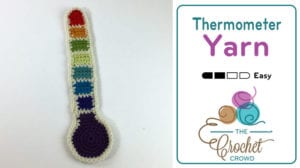
Thermometer Applique
I have written a pattern called the Yarn Thermometer. This pattern will show you how to make an applique that can be applied to your Temperature Afghan.
The colours you have selected for your project are to be used in the thermometer. Once you are done this applique and your project are done. Simply sew this onto the corner of the afghan.
To help you remember what the colours mean, the gauge shows the colours in order of the temperature. So when you look at the project, you can look at the thermometer and remember the temperature increments.
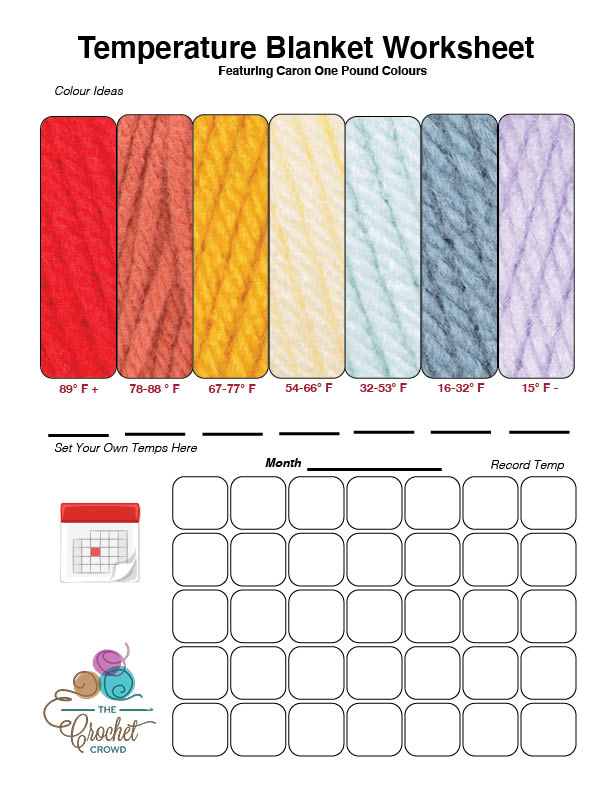
How Many Chains to Start Worksheet
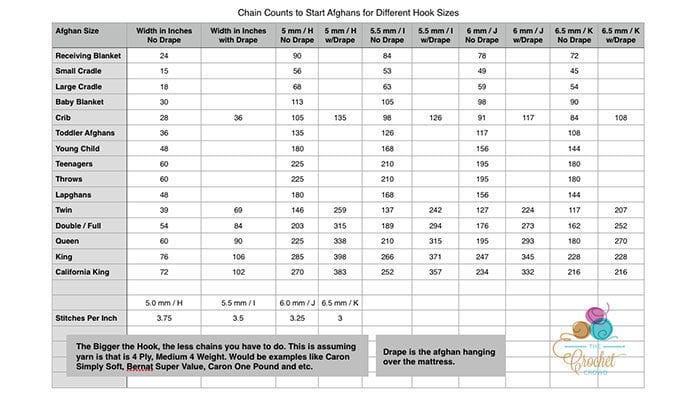
Tips on Selecting the Right Stitch
The Afghan may be up to 365 rows. Based on single crochet using Caron One Pound with a 5 mm or H Hook, 3 days equals 1 inch of height. This means the afghan will be 121" long. If you have seen most temperature afghans, it's way too long and isn't practical.
So I attempted doing slip stitching and I know what you are thinking, 'Slip stitching' an entire afghan is crazy. But wait. You have to do 365 rows. Slip stitching with 5 mm or H Hook using Caron One Pound, you can get 8 days in just 1". This will give you an afghan that is really tight and approximately 46" long instead.
If you want texture, when you are slip stitching, use the front loop only. This will give a unique look and make the afghan have elastic look and feel to it.
If you do a lapghan size of 180 chains to start. You can create an almost square lapghan. Then you can add on a border to make it slightly bigger.
Tutorial
What Types of Projects Can You Do?
It's usually done in granny format but you can follow your own rules or designs. Here is a list of 5 patterns that are great for this. Again, be creative.
Sabine Jordan says
I tried to make one, but fell behind and then gave up (the Weatherghan thing wasn't even close to accurate for our temperatures). Our temps fluctuate greatly, throughout the year as well as the day. During the year we get everything from the teens in Winter, to 120 degrees in summer. I did 10 degreees for each color and ended up with like 11 or 12 colors. Right now, we're waking up in the 20s or upper teens, but then it goes up to at least the 40s, if not 50s, or sometimes a 60. In the summer we wake up to 50s or 60s and it goes up to at least 90s if not 100s most days, so that's like 6 or 7 colors, per day; just too much. Using every color from the various temperature/color zones proved to be way to labor intensive because of our great temperature fluctuations. I am trying to come up with a different breakdown of colors, maybe do every 15 degrees instead of every 10 degrees.
Mikey, The Crochet Crowd says
have you contacted the owner to inquire about accuracy. I know she worked months on that.
Helen Sullivan-Doucet says
I would pick a certain time of the day and use that temperature. Using the same time for every day for example 2:00 pm everyday and the temperature at that time
Teana says
go by just the H or L of the day pick one or both and go with that
Jodi says
Pick Pickard a time of day to check the temperature everyday and that's your color for the day, or you can choose the high of the day in summer and spring and the low in winter and fall. There are area number of options but you want to do one row a day because it's going to come out very long by the end of of a year. I did my first one this year in a single crochet stitch and it all ready goes from the top of a king bed and is hanging over the foot by about 7 to 8 inches.
Gerda says
Why not try a variegated/multi strand yarn for those days our colors are the same
Ashleigh C H Upadhyaya says
The temperatures in NC, US vary that much also. I am going to do high and low for the day (weather . Com is pretty accurate for me, if you are in the US). I am going to use worsted weight for high, and walmart sells floss next to the yarn in lots of colors, which I will use for the low. I hope you can finish your project one day!
Marlena Abbott says
I have a simulare problem. I'm getting ready to start my first temperature afghan. I'm doing mine to show my grandfathers battle with cancer, he's at end of life so it's going to be a sort of memorial blanket. It's only going to cover from last august through the day he passes away which will probably be really soon. We live in Houston, and sometimes there's a 20-30 degree change in one day. I was able to find a site, though, that gave the high, low, and average temps for each day. Since I'm not doing a full year I'm considering doing a row for each temp. I might just do the high and low. I'm having trouble deciding. If anyone has a suggestion that would be great.
Kitty says
This is awesome, I'm going to do for my dad with the temps of the year he was born.
Sheila says
That's a great idea! How are you looking up the temp for it?
Kitty says
I just googled it. If you are Canadian the government of Canada website has historical weather information and you can even download it to an excel spreadsheet to make it easier
Denise says
every time I put my zip code and the year. ( 2017 ) it comes up that I have an error. I do not know what I am doing wrong. HELP thanks Denise
Jeanne - The Crochet Crowd says
Maybe because 2017 hasn't happened yet...
Tanya LaVallee says
2017 hasn't happened yet.
kitty says
That's because 2017 hasn't started yet so there is no data